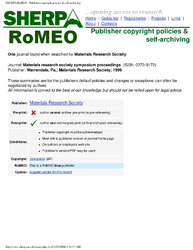| dc.contributor.author | Heben, Michael | en_US |
| dc.contributor.author | Dillon, Anne | en_US |
| dc.contributor.author | Gennett, Thomas | en_US |
| dc.contributor.author | Alleman, Jeffrey | en_US |
| dc.contributor.author | Parilla, Philip | en_US |
| dc.contributor.author | Jones, K. | en_US |
| dc.contributor.author | Hornyak, G. | en_US |
| dc.date.accessioned | 2006-07-19T20:09:46Z | en_US |
| dc.date.available | 2006-07-19T20:09:46Z | en_US |
| dc.date.issued | 2001 | en_US |
| dc.identifier.citation | Proceedings of the 2000 Fall Meeting 633 (2001) A9.1.1-A9.1.11 | en_US |
| dc.identifier.uri | http://hdl.handle.net/1850/2268 | en_US |
| dc.description | Article may be found at: http://www.mrs.org/s_mrs/bin.asp?CID=2385&DID=54951&DOC=FILE.PDF | en_US |
| dc.description.abstract | Laser-generated, carbon single-walled nanotubes (SWNTs) adsorb hydrogen in a matter of minutes at room temperature and atmospheric pressure in the presence of a Ti-6Al-4V metal alloy. The unusual hydrogen adsorption properties are activated when the SWNTs are sonicated in nitric acid with a Ti-6Al-4V probe. The process cuts the SWNTs and introduces ~15-40 wt% metal alloy into the previously pure single-walled nanotube material. Subsequent hydrogen adsorption occurs in two separate sites with a maximum adsorption capacity of ~7 wt% on a total sample weight basis. Approximately 2.5 wt% hydrogen is evolved at 300 K while the remainder desorbs between 475-850 K. The pure metal alloy adsorbs ~ 2.5 wt% H2, and evolves hydrogen with increasing temperature in a manner similar to the alloy-doped SWNTs. However, it is clear from studies presented here that the SWNT fraction is quite active in H2 uptake, adsorbing as much as 7 % on a SWNT weight basis. | en_US |
| dc.description.sponsorship | This work was supported by the Office of Science, Basic Energy Sciences, Division of Materials Science and the Office of Energy Efficiency and Renewable Energy Hydrogen Program of the Department of Energy under Grant No. DE-AC36-99GO10337, and by Honda R&D Americas, Inc. We are grateful to Leonid Grigorian for reading the manuscript and for providing helpful suggestions. We also thank Alan Cooper and Guido Pez for many helpful discussions concerning the hydrogen storage mechanism. T.G. worked at NREL while on sabbatical from R.IT. This work is dedicated to the memory of John D. Webb. | en_US |
| dc.format.extent | 26759 bytes | en_US |
| dc.format.mimetype | application/pdf | en_US |
| dc.language.iso | en_US | en_US |
| dc.publisher | Materials Research Society 2000 Fall Meeting: Symposium A: Nanotubes and Related Materials | en_US |
| dc.subject | Carbon nanotubes | en_US |
| dc.subject | Hydrogen adsorption | en_US |
| dc.subject | Metal alloys | en_US |
| dc.title | Rapid, room temperature, high-density hydrogen adsorption on single-walled carbon nanotubes at atmospheric pressure assisted by a metal alloy | en_US |
| dc.type | Abstract | en_US |

